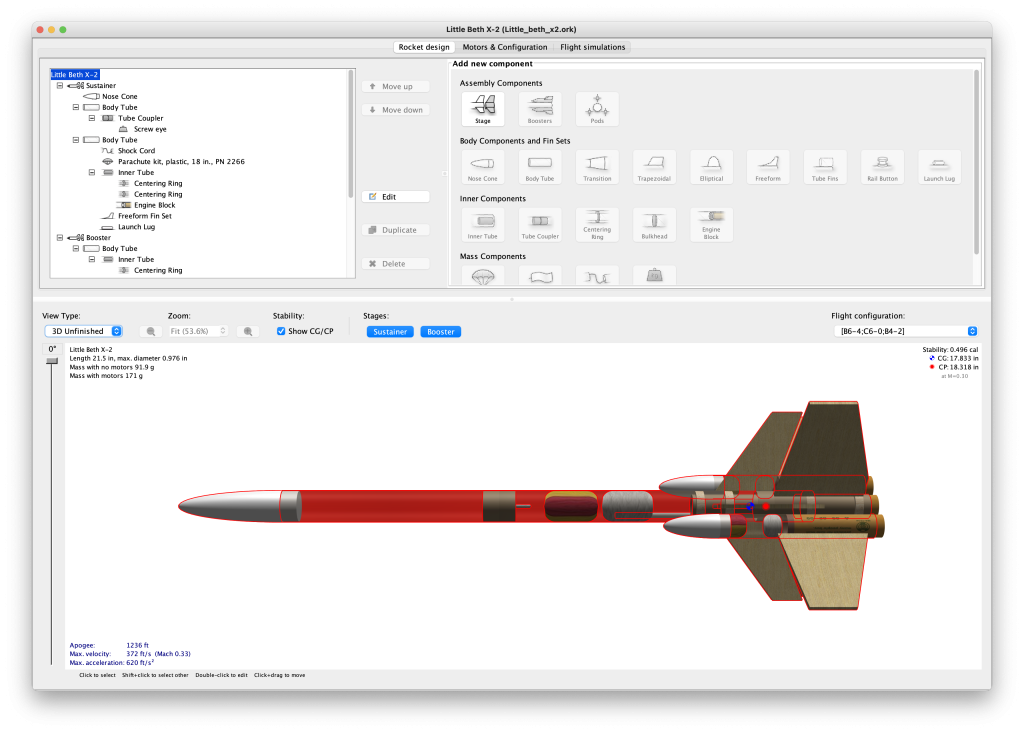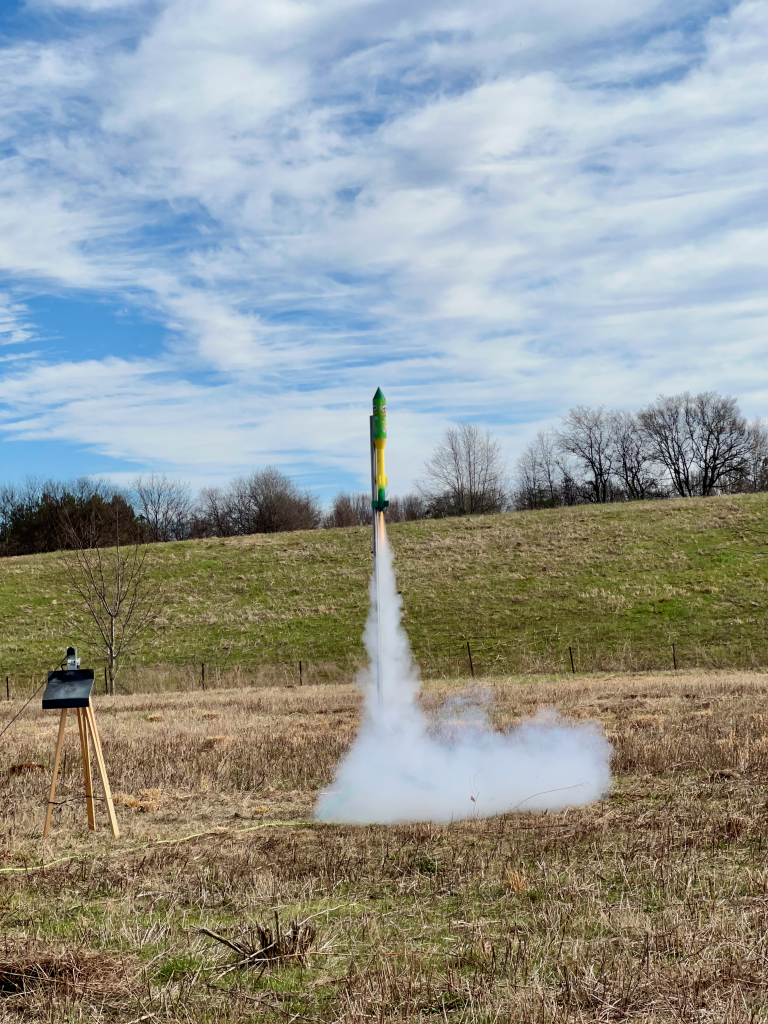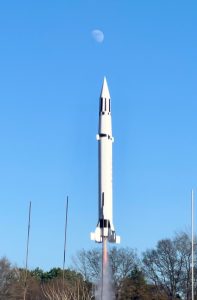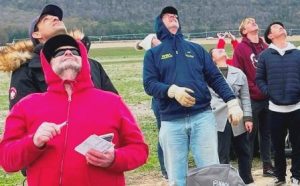Tomorrow’s (Saturday, February 11) launch is scrubbed!
Learning to respect OpenRocket – thanks to NARCON!
Like many others involved with TARC, I’ve used OpenRocket for years – it’s easy to use, has a nice database and is quite suited for designing simple 3FNC or 4FNC rockets. But for more complex models – such as those with pods, “fins on fins” or elaborate clusters/stages, I use Rocksim. It can handle almost any design, plus you can easily adjust things like the rocket drag coefficient to match the rocket’s flight data. Couldn’t do that in OpenRocket 15.03, which is the last stable version, released almost 8 years ago.
Plus there’s the fact that OpenRocket uses JAVA, which often caused installation problems for users. Fortunately that changed when the developers created installers for the various operating systems (Windows, MacOS and Linux) that eliminated the need to futz with a separate JAVA installation. However, OpenRocket 15.03 uses JAVA 8 whereas modern operating systems have gone to JAVA 11; for example, Mac users running Ventura (the latest Mac operating system) can no longer run 15.03 because Ventura has no support for older versions of JAVA. The good news is that the developers have released a pretty stable beta version of OpenRocket (22.02.beta.05). It not only runs under Ventura and other operating systems, but also sports some new capabilities previously found only in Rocksim. I’m going to touch on a couple of these, the first being the ability to manually set the rocket’s drag coefficient.
After the Geezer TARC launch, I received the altimeter profiles from the flights of Duane’s rocket as well as a question – “Why are the OpenRocket simulations so far off from the actual flight profiles?” The answer is pretty well known – OpenRocket 15.03 controls drag by setting the “roughness” of the component surfaces, i.e., “Smooth Paint”, “Unfinished”, etc. It tends to underestimate drag of the components and the model as a whole, resulting in simulated peak altitudes that are too high, by a significant amount. In fact, we tell our TARC teams to try for simulated altitudes 100 feet higher than the TARC goal in order to compensate for this issue. However, the new 22.02 version of OpenRocket allows you to manually set the drag coefficients of the various parts, and I decided to test this against Duane’s flight data.
There are 5 curves plotted in the below graph. The 2 blue curves are the flight profiles from the onboard PNUT altimeters, whereas the red dashed curve is from a Rocksim simulation with the drag coefficient set to the standard 0.75. It tracks pretty well with the data. Note that the OpenRocket 15.03 curve predicts an altitude way too high, by about a hundred feet. But when I import Duane’s design into OpenRocket 22.02 and play with the drag coefficient, I get a nice performance match. The advantage in doing this is that I can now accurately estimate how this model will perform with different motors or weather conditions. And so can TARC teams with their rockets – without having to shell out the bucks for Rocksim.
The other capability I learned from the NARCON talk is how to use pods and boosters. To test my knowledge, I created a simulation of the Estes Little Beth X-2, an old Design of the Month model that has a clustered (3 motors) lower stage with dual parachute recovery mated to a single motor upper stage. There would have been no way to realistically model this rocket in 15.03, but it was a snap to do in 22.02 – took all of 30 minutes. I was able to model all the rocket components and the simulation handled all aspects of the flight, including the booster parachute deployment from the side pods.
Very nice!
So please download the latest beta version of OpenRocket. While it doesn’t have all the capabilities of Rocksim, it is catching up thanks to a team of dedicated volunteer developers. Also, you can’t beat the price!
Link to OpenRocket 22.02.Beta.5: https://openrocket.info/downloads.html?vers=22.02.beta.05
Geezer TARC showdown…
A few of us took advantage of the nice weather on Saturday to conduct this year’s long-delayed Geezer TARC flyoff at Pegasus field. It was the usual cast of characters – Doug, Duane, Vince and me, along with a few spectators. People began arriving at the field around 9:30; within half an hour the range was set up and ready to go.
First off the pad was HARA President Doug Aguilar, flying his scratch built rocket with the Pringle’s can payload section. He chose an Estes E16-8 motor for his initial flight, which did not quite have the impulse needed to reach the 850 foot goal. The rocket only made it to 496 feet, and the 8 second delay – which would have been great if the rocket had made it to the goal – was too long, ejecting the parachutes when the rocket was speeding towards the ground. The parachute ripped away from the payload section, resulting in a disqualification. Fortunately, nothing was broken and the rocket was readied for its next flight.
The second flight was made by NAR advisor Vince Huegele, who had Frankensteined together a rocket from pieces of various kits – a tradition for him. His model featured the plastic egg capsule from an Estes Scrambler, connected to a 2 piece BT-56 body tube and 3 trapezoid fins scrounged from another kit. It was also the only rocket to use launch lugs. The lightest of the rockets flown at the launch, this classic-looking egglofter was powered by a single Estes E12-6 motor.
Upon ignition, Vince’s rocket left off the pad, soaring past the mark to 943 feet. Naturally, the rocket took a long time to descend to the ground, with the egg capsule touching down 77 seconds after launch, well outside the 42-45 second TARC duration window. Realizing he needed to add weight to the rocket, Vince spent quite a few minutes looking for a suitably sized rock he could use as ballast for his second flight.
The reigning TARC Geezer, HARA Treasurer Duane Mayer, was next. His rocket was a simple 3 fin BT-70 based model, using an Aerotech E18-7 reload for the motor. Duane’s years of experience showed as his rocket reached apogee at 865 feet, only 15 feet above the mark, and was slightly short on duration at 38 seconds, 4 seconds outside the window.This put him in the lead, but it was clear that the ejection charge fired late, causing the model to fall from apogee more than was comfortable.
My flight was the last in the first round. My rocket, Oeuf, was a simple model using Semroc ST-18 body tubes (the smallest diameter that can accommodate a “regulation” TARC egg) and upscaled Alpha fins. I designed her to be versatile, so the motor mount was a four engine cluster, capable of handling 2 or 4 18mm motors. For this flight I decided to keep the “pucker factor” associated with cluster launches to a minimum and chose 2 Quest D16-6 motors.
Both motors lit, and Oeuf flew perfectly straight to a respectable 879 feet, with the payload section touching down in just under 42 seconds. However, the sustainer parachute did not leave the body and the lower part of the rocket came streaking in, burying itself to a depth of 5 inches in the soft ground of Pegasus field. So my would be score of 31.5 – which would have put me in the lead by one point – became a disqualification. Not only that, but the rocket was too badly damaged to fly again – I was done for the day.
The 2nd round of competition flights was fairly uneventful – I watched as Doug swapped the Estes Estes E16-8 for an Aerotech F30-7, which pushed his rocket up to 925 feet. Way too high, but at least he made a qualified flight. Vince followed with his rock-ballasted egglofter, which reached a too-short 777 feet and stayed up way too long – the payload section parachute was too large. Duane’s second flight came last, hitting 880 feet and landing in 39.8 seconds, ensuring he would once again be crowned the TARC Geezer. Even though his final flight went higher, Duane did mitigate the too long ejection charge issue by drilling away some of the reload’s delay. He thought he shaved off 2 seconds, and the altimeter profile shows that he came near to that.
Geezer TARC 2022-2023 was over. Once again, Duane took home the victor’s trophy and will have another year’s reign as the best TARCer. As for me, I got the Flying Pig award for the worst flight, which sits right next to my Skunk trophy awarded for worst flight at a past Geezer TARC. I came so close, but a stupid mistake – which I am too embarrassed to reveal – cost me my chance at TARC glory.
There’s always next year…
No launch this Saturday (Jan 21)
Tomorrow’s (January 14) launch is scrubbed!
First 2023 Launch
HARA got out on the field on day one of 2023 with an impromptu small model launch unable to resist the unseasonable 70 degree sunny day. See more photos, videos and notes at the HARA facebook page-
https://www.facebook.com/profile.php?id=100064693116419
The next launch is scheduled for 1/14/23 at Woodville.
Novemburr Air
The scheduled launch day on 11/12 was rained out by a hurricane, but by the next weekend the November air was mostly clear, calm, cold, but good enough to fly. There were 38 flights in a fairly even distribution of motors from ‘A’ to ‘J.’ Several ever present school teams brought their birds and other club members brought theirs. As the sky went overcast in the afternoon, the rocket flames showed even up brighter.
Nice October Sky
HARA’s launch season began well with a two day launch on October 15 and 16,2022. Weather was a little breezy on Saturday and lower winds on Sunday and clear skies both days. There were 62 recorded launches with a CTI K360 being the largest size flown. Sunday attendance was very light with only about two dozen flights. Models of all types tested the air landing in the freshly cut field.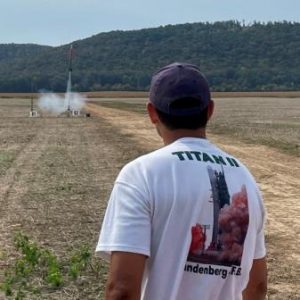



TARC Workshop
HARA kicked off the TARC season with a workshop conducted by Duane and Bill Saturday Sept 17. After an overview of sim programs and data interpretation by Bill, Duane led the students in building a eggloft model. This was the first workshop since covid and it was fun to get back with the kids.



NAR Website Excellence
The winners of the 2022 NAR Section Website Excellence Awards were announced during the NARAM banquet in July and HARA’s website came in 4th Place. The judging was conducted by volunteer NAR members and of the scores received, this website ranked in 4th Place out of over 120 websites that were judged. There are 220 NAR sections. See details at https://www.nar.org/find-a-local-club/section-guidebook/communications/website-excellence-award/
HARA’s website won first place in 2014.
Congratulations to webmaster Bill Cooke!



